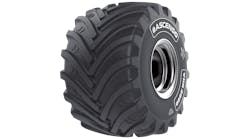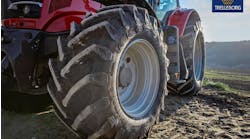QUESTION: Why is a tire, when run at slower speed, able to carry the same load at lower air pressure?
NICK PHILLIPPI: product manager, technical support North America, Ascenso Tires North America: I am not a physicist and the deep mathematical calculations and presentations are for others to give. But as a tire person, the central subject for this question has to do with the law of coefficient of friction. The faster an object moves against another object the more heat is built up and all tire folks know that heat is the worst enemy of a tire.
The load, air and speed ratings of tires are set based on maximum speed, maximum load and maximum air. The slower the operation is as compared to the maximum speed rating of the tire, the more weight the tire can handle safely. Now, as always, all tire data is based on five criteria:
- Tire in new condition;
- Wheel in new condition;
- Equipment in new condition;
- Surface flat and free of obstacles; and
- No extreme ambient or surface temperature.
In short, the end user and tire service professional need to be aware of any of these factors that may impact the ability of the tire to operate safely.
Very-high flexion (VF) tires are being used more and more in lower speed or variable speed settings, requiring the new load charts to give direction on capacity at lower speeds and in intermittent speeds/loads. As more VF tires are produced and more data is available in the market on performance - along with more testing being conducted - it has given reason to create the new charts and to be sure existing and past load index charts were accurate.
Central Tire Inflation Systems (CTIS) are an absolute necessity to get tires operating at the proper and lowest pressure possible to minimize compaction and meet optimum fuel versus slip. Although CTIS today only uses the measured worst case scenario weight to adjust the air in the tire from faster road to slower field speed - not taking into consideration live load changes - it is so much better than any chance producers will adjust pressure from field to road, or even between pieces of equipment.
DAVE PAULK, manager, field technical services, BKT USA Inc.: At field speeds, five t0 10 mph, tires can be run with less air pressure to get a longer and wider footprint to better distribute the weight of the tractor and/or implements. This allows for better traction (fuel economy) and less ground-bearing pressure (soil compaction).
As speeds increase, the load carrying capacity of the tire decreases. The low air pressures that can be used at field speeds are not the same air pressures that should be used at highway speeds. Higher air pressure must be used to carry the load at a faster speed. The higher air pressures create a smaller footprint for lower rolling resistance on the road.
Using a load and index chart is helpful to eliminate possibilities of damaging the tire by overloading and underinflation. The load and index chart gives weight carrying capacities at different speeds and air pressures. Less air pressure equals less soil compaction in the field. As noted, the air pressures must go up for road transport at higher speeds. Currently, to accomplish this, one must reduce air pressure in the field and inflate the tires before taking the tractor on the road. An air compressor is needed to do this. CTIS are being developed and will be built into the tractor to perform this function. Air pressures can be reduced in the field and pressures can be increased, as needed, for the road. This can reduce compaction and increase fuel economy in the field and minimize tire failures on the road. Running a tire with low air pressures at highway speeds creates heat buildup in the tire. It can’t dissipate the heat quickly enough over long distances and can lead to ply gap turnup and sidewall separations.
Standard tires can be used with less air pressure at slower speeds. With the increased flexion (IF) and VF tires, air pressures can be reduced even more at field speeds. A VF tire will carry 40% more weight at the same air pressure as a standard tire of the same size. At slower speeds, air pressure can be reduced even more to minimize compaction.
As stated, lower air pressures can be used at slower speeds if enough air is used to carry the weight of the tractor and equipment. Proper air pressure for the weight carried, whatever that may be, is required so that the tires are not overloaded. There are times when low air pressure can’t be used. Overloading tires will lead to bead and sidewall failures in the field. An example is sprayers, since at times they run at faster field speeds than tractors and start loaded with liquid. Another example is using a 16-row planter on a three-point hitch. With the planter down at field speed, air pressure can be reduced. When it gets to the end of the row, the planter must be picked up to turn. This is a lot of weight on the tires with low air pressure. Worst case scenarios should be considered when deciding the correct air pressure for the application.
IF-CFO and VF-CFO tires are used in cyclic applications such as grain carts and combines. CFO is an abbreviation for Cyclic Field Operation. These applications start with the hoppers or carts empty and build up weight over time.
When they are full, they are dumped and start empty again. Because of this, the weight of the machine is constantly changing. The load is cyclic. For these applications, load bonuses are given at slow speeds (field speeds at five to 10 mph and 10 to 20 mph) for a specified distance. On the previous page, an example is shown of a 1250/50R32 201B IF-CFO tire used in this application. At five to 10 mph, this tire has a 55% load bonus without changing air pressures. At 10 to 20 mph, the tires have a 30% load bonus. These factors are not to be used when considering air pressures for tractors. Tractors generally have a constant weight and are not cyclic.
Although sprayers may be considered cyclic, they are cyclic in reverse. Sprayers start heavy and full. As they use the liquid in the tanks, they get lighter. Instead of going from light to heavy like combines and grain carts, they go from heavy to light.
The faster the speed a tire travels, the less weight carrying capacity it has. The slower the speed, the more weight carrying capacity it has. This is true for all tires. This can be seen in the load capacity chart. When deciding how much air pressure to run, always look at the worst-case scenario and use that to decide.
GREG GILLAND, vice president, global agriculture, Maxam Tire North America Inc.: In a previous article, we covered the differences between radial and bias tire construction. In summary, the primary difference between radial tires and bias ply tires is in the tire carcass, as well as the material construction of the tire.
The key difference between the two types of construction is how the radial tire uses the single radial casing as a spring mechanism that pushes the working belts onto the working surface, ensuring a uniform contact patch or contact area for the tire tread. This delivers both the necessary traction and friction, carrying the required load in any direction under power. The improved footprint and traction delivered by radial tires has accelerated the adoption of radial tires as the primary construction type on both new and older agricultural equipment. With the performance advantage created by the radial casing, the air pressure in the chamber takes on a larger part of the load carrying capacity, moving from 60% to 80% of the axle load carrying capability:
The radial advantage is delivered by the air pressure in the inner chamber that fluctuates per the given axle load, whether mounted as a single tire, dual or triple fitment. All tires are a compromise, as load and speed, radial casings and rubber compounds have been enhanced over time. This allows the tires to operate at higher speeds and absorb the heat generated by the friction of the road versus a given axle load. Over the last 20 years, we have seen radial tires evolve from the traditional dual speed rating of A8 = 25 MPH / B = 30 MPH to a D rating = 40 MPH capability as the market demands and requires faster capabilities. In every case, the rubber compounds, as well as casing materials, must be engineered to not only carry the loads but have the endurance to deflect or flex up/down as the tire absorbs the energy generated by both load and speed.
The biggest threat to tire failure is excessive heat generation caused by overload or overspeed. Overload occurs when tires are underinflated for the axle load. Overspeed failures occur when tires are either overloaded, don't have enough air pressure for the rated speed and/or operated above their speed rating, increasing the friction coefficient of the tire rubber compounds.
As a rule, the key to load bearing capability is the correlation between the actual weight being carried and the machinery speed. If the tire inflation pressure is set to the right inflation pressure based on the axle load for a given speed, the tire is designed to deflect and absorb the heat, delivering performance and endurance.
If you slow the machinery speed without changing the air pressure in the chamber - already at a higher pressure - the air in the chamber allows for heavier loads to be carried as heat generation caused by the friction or tire flexing is reduced dramatically. This reduces the heat in the inner chamber that is normally generated between the air molecules. In all cases, tire manufacturers abide by industry standards that reference principles of temperature and air pressure to determine the optimal speed, weight bearing capability, and resulting heat generation for a given tire size air chamber.
If you choose to lower the air pressure, then the load being carried must be measured so that the correct lower air pressure for that given speed is identified, thus allowing the air molecules in the chamber to heat up without overheating the tire.
The advent of IF or VF technology has allowed some of the above rules to be re-written, transferring back to the casing materials a greater share of the load carrying technology. For agricultural tires, whether using IF or VF technology tires, farmers can either significantly lower air pressure without compromising the carrying capacity of the tire or increase the weight carried with the same tire footprint or same gross flat plate.
Both technologies allow farmers to achieve better yields or greater productivity in the field with heavier or faster machinery.
Specifically, VF tire technology construction uses different casing and rubber materials to achieve the benefits mentioned earlier, by delivering the product solutions below in comparison to the standard tire construction:
- VF tires provide the greatest load carrying or axle load capacity at standard air pressures as needed;
- When operated at minus-40% air inflation pressures, VF tires will reduce soil compaction improving crop yields;
- VF tires are designed to operate safely with a higher heat resistance of the casing despite the minus-40% lower air pressure;
- The ability to lower air pressures also improves the ride and with a greater contact patch (or flotation) as traction improves;
- VF tire pressures, when operating below 40% air inflation, also greatly enhance both traction and stability when on slope fields, and;
- The above conditions are matched on IF technology tires except the benefits are only 20% greater than standard tires.
The growing use of on-board CTIS technology has created a feedback loop adjustment tool supplied by the machinery that is connected to the tires. This includes the capability to inflate or deflate the tires as needed, based on the required speed or working axle load demand. CTIS receive data from either an RFID or sensor tag, located by wheel position on the machinery, and give the operator the capability to adjust the tire inflation pressure in real time and as needed without having to stop the machinery. Whether working in the field at slow speeds or transporting the machinery (roading) from field to field at higher speeds, the ability to adjust the tire air pressures as needed can ensure the following benefits:
- Reduced ground compaction as tire load is based on the actual load per axle or per tire as needed;
- Greater crop yields as the compaction impact on the soil is minimized by the improved tire footprint;
- Improved tire wear and reduced sidewall deflection giving the optimum tire gross flat plate or footprint;
- Improved fuel efficiency as the tire is optimized for each work application or towed implement, and;
- Greater productivity in the field as the tire’s footprint and traction provide increased efficiency.
DAVID GRADEN, operational market manager, agriculture, Michelin North America Inc.: I would like to start with rephrasing this question to, “Why does a tire require more air pressure at faster speeds?” As a tire rolls, the perfectly circular shape of that tire transforms. The bottom flattens out and rolls over bumps and through divots. As the tire rolls faster, the circular shape transforms to more of an oval or oblong shape. This transformation creates a couple of concerns.
First, the structural integrity of the tire is being compromised more often as speed increases, and more significantly as air pressure decreases. You would think lower air pressure at higher speeds would create a smooth ride. However, it also creates bouncing, which can overload a tire each time downward pressure is applied.
As the structural integrity of a tire is compromised more often with higher speed and the casing is more deflected at lower air pressure, heat increases. In severe cases, underinflated tires at high speeds will cause that tire to fail from the inside out. The radial belts will separate, carcass plies will break and pull apart and the rubber will begin to melt.
The second concern is the stability of the vehicle. At lower speeds and air pressures, an operator can easily maneuver machinery over bumpy terrain and around obstacles. At higher speeds and lower air pressures, however, it becomes much more difficult for the operator to manage these tasks. Think about a high-clearance sprayer. As this top-heavy machine makes a sharp turn, the tires will flex and the machine’s weight will shift to one side, overloading the tires on that side and possibly failing. If the tires are set to proper inflation pressures, they will be able to handle the weight shift and limit the leaning of this machine to one side.
Why can a tire carry more load at lower speeds and air pressures? A tire deforms more often at higher speeds, creating more heat — the worst enemy of a tire. At lower speeds, the opposite is true, and the structural integrity is better preserved. Simply put, this lack of stress on the tire carcass allows it to carry more load.
When we consider the daily activities of most farm machines, they aren’t always operated at the same speed or load. This is exactly where Michelin’s PTG CTIS comes into the picture. We know machines operate much more efficiently at lower air pressures in the field, and are more stable at higher pressures while traveling down the road at higher speeds. Unfortunately, I’ve never met a machine operator willing to stop what he or she is doing to change air pressures before each of these activities.
With PTG, there is no need to manually change air pressures or even stop the machine, for that matter. With the push of a button, a machine operator can change tire pressures for up to two axles and an implement. This technology now enables producers to gain full operational efficiency of their machinery. Full operational efficiency means maximum traction, floatation, fuel efficiency, stability and rider comfort.
Finally, several years ago, Michelin was one of the first manufacturers to begin designating harvester and sprayer tires with CFO Load Bonus — enabling even heavier loads than standard, at specified slow speeds, for a limited distance.
Look at this Michelin Spraybib, as an example: VF380/90R46 173D CFO (Cyclic Field Operation)
- Standard VF: At 6 mph (10 km/h), 12 psi carries 4,795 lbs. for an unlimited distance;
- VF CFO: At nine mph (15 km/h), 12 psi carries a cyclical load of 4,960 lbs. up to 1 mile.
As I mentioned earlier, typically, a tire can carry heavier loads at slower speeds, so why does this example not follow that same rule of thought?
Since the sprayer is getting lighter as herbicide is used, we only need the CFO tire to carry the load for one mile — limiting the amount of times tire deforms. Hence, we can increase the load more than standard temporarily.
KEN BRODBECK, vice president of technology, Precision Inflation LLC: A tire’s tread and sidewalls flex rolling through the footprint. Internal friction from flexing creates heat. Tire temperatures can easily go above 200 degrees Fahrenheit and start to cause the rubber to revert or become gooey. Then the tire can fail.
The slower the tire goes, the less heat is generated. And a higher load can be carried without overheating.
Michelin now offers higher cyclic loads for sprayer tires up to 20 mph field speeds.
An example:
A VF 420/95R50 179D/175E: VF is an Ultra High Flex Tire that provides a large, long footprint with heavy loads, carrying same weight at 40% less air pressure than standard tire. At 55 psi, the tire will carry 16,570 pounds at 40 mph. At 20 mph the tire will carry 18,740 pounds, or 13% (more than) the 40 mph load.
A 1,200 gallon sprayer with 28% fertilizer has the following loads per tire in road and field configuration.
No Central Tire Inflation System:
Roading, 40 mph loads (folded boom)
Front lbs. psi Rear lbs. psi
13,400 39 12,000 30
Field, 40 mph loads, (unfolded boom)
Front lbs. psi Rear lbs. psi
10,200 25 15,200 47
Without changing tire pressure, the required psi is 39 psi for the front and 47 psi for the rear.
With a Central Tire Inflation System:
By changing tire pressures on the go with CTIS, up to 20 mph, air pressure can be reduced.
Field, CFO 20 mph loads (unfolded boom)
Front lbs. psi Rear lbs. psi
10,200 20 15,200 39
Changing tire pressure with CTIS, accommodating load and speed change, the required psi is 20 psi for the front and 39 psi for the rear. That’s a 49% decrease in psi.
Air pressure reduction directly correlates to reduced soil compaction. Using slower speed tables with CTIS provides increased yield, reduced fuel consumption and increased efficiency.
CHRIS NEIDERT: ag marketing, training and development manager for Trelleborg & Mitas Tires – North America, Yokohama TWS: Pneumatic tires are designed to be flexible and adaptable to the application in which they are operating. Because of the weight they bear, tire sidewalls bulge under load and their treads flatten to increase the contact area and traction as they roll.
This sidewall bulge results in a dimensional difference between the tire’s “unloaded” radius (i.e., between the center of the axle and the top of the tire) and its “loaded” radius (between the center of the axle and the road) called “Static Loaded Radius” (SLR). Engineers call this radial deflection.
When a tire travels on the road or field it rotates and constantly changes its shape between the unloaded radius and the loaded radius form. Increasing the vehicle speed will increase the frequency of this change and cause the tires to deflect at a faster rate. This is an important point to remember to understand the internal chemistry of the tire components.
This involves a term called “hysteresis”. Hysteresis is the percent of energy loss per each deformation. Hysteresis results from friction happening inside the rubber which creates heat buildup. The heat buildup in the rubber is measured as the temperature increases from hysteresis. You want to keep the amount of hysteresis low.
With that being written, when a tire is rotating at a slower speed, the deflection cycle is slower allowing the tire more time to cool down when it’s in the less deflected position.
In other words, the heat is generated on the bottom part of the tire and the upper portion of the tire cools down. The faster this cycle, the less time the upper part of the tire has to cool down.
Each tire size uses a certain air pressure to carry a specific load at a specific speed. Conversely, when the tire’s speed increases, as in moving from the field to the road, and the air pressure is not increased, the speed of deflection movement increases and the amount of deflection increases. This will build up additional heat in the tire, reducing tire life and possibly creating a tire failure. Tire air pressure must be increased when speed is increased.
The same will hold true for a load increase. If no air pressure adjustment is made, the amount of deflection increases. Heat buildup happens. Tire failure is possible and tire life is reduced. Tire air pressure must be increased to reduce that deflection. Higher inflation pressure results in a “stiffer” tire sidewall, less deflection and less heat buildup.
We at Trelleborg and Mitas have always said the ideal situation is to run one air pressure in the field and another air pressure on the road. This will give optimum tire performance and tire life. A Central Tire Inflation System (CTIS) would accommodate this recommendation with its ability to change air pressure on the fly.
When IF technology was first introduced the decision was made to make the load tables as easy as possible to use. Hence, the load table was designed so that no matter what speed you were traveling, one air pressure was recommended. Example: if you need to carry 18,850 pounds, you would need to run 26 psi whether your speed was 40 mph or 5 mph.
As tire materials and design technology have improved, the tire international standards organization has recently introduced additional load values when speed is reduced. Tires built with IF and VF technology have new expanded load tables.
The exact same tire, but with an expanded load table, we can better suggest an air pressure based on the application. We will use an application doing some slow speed work (5 mph) in a low torque (LT) application. (The table) would suggest 20 psi. Quite an air pressure reduction from the 26 psi we would be recommending with the old table.
The reduced air pressure will increase the size of the tire’s footprint, reducing the ground pressure, reducing compaction, and improving yield. Tire performance will be better for the grower.




